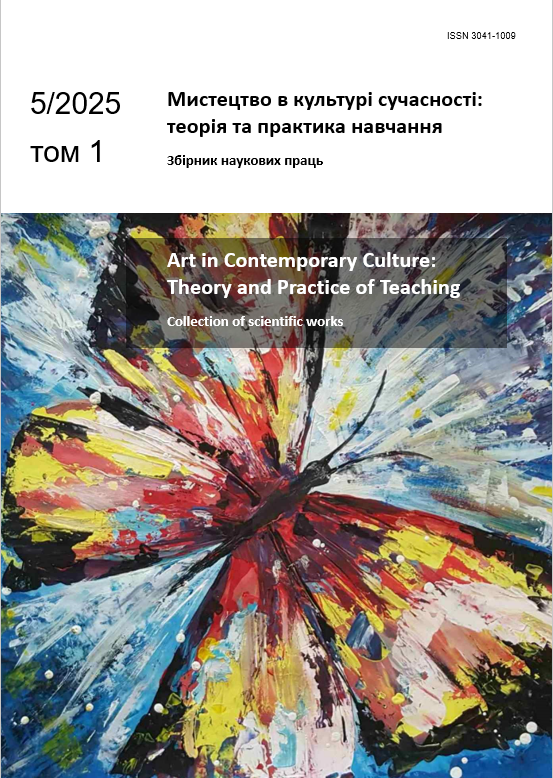Published 2025-05-15
Keywords
- art therapy, creativity, psycho-emotional state, war, stress, anxiety, children, military, rescuers, psychological rehabilitation, trauma, recovery, psychosocial support, methods of art therapy, psychological assistance, post-traumatic syndrome

This work is licensed under a Creative Commons Attribution 4.0 International License.
How to Cite
Abstract
The article discusses the role of art therapy as an effective method of supporting the psycho-emotional state in war, in particular in the context of children, military and rescuers. The author describes how creativity, through various art therapy techniques (drawing, modeling, theater therapy, music, dance), allows people to release and experience their emotions, reduce stress and anxiety. Art therapy acts as a tool for restoring psychological balance, helping to overcome the effects of trauma and providing resources for recovery. Attention is focused on the importance of timely psychological assistance and support for those who have suffered trauma during the war, as well as on identifying the categories of professionals for whom art therapy is most effective.
Art therapy is an effective method of maintaining the psycho-emotional state in times of war, as it reduces stress and anxiety, promoting emotional healing and restoring psychological balance. This method helps to express complex emotions, particularly in cases where verbal expression of feelings is difficult. Art therapy is most effective for military personnel, children, and people who have experienced trauma or loss. The method has shown its ability to reduce stress and adaptation in the face of post-traumatic experiences. To achieve maximum effect, it is important that art therapy is conducted by qualified psychologists and art therapists with experience in dealing with post-traumatic disorders.
Art therapy is especially effective for such categories as the military, rescuers of the State Emergency Service of Ukraine, people with PTSD, and children in war. Military personnel often face traumatic situations that include loss and psychological trauma. Art therapy allows them to express difficult emotions and improve their emotional adaptation after combat. Rescuers of the State Emergency Service of Ukraine who work in emergency situations can relieve stress and emotional tension through creativity, which helps to avoid stress-related diseases. For people with PTSD, art therapy is an important tool in dealing with traumatic memories and alleviating symptoms of anxiety, depression and aggression.
Downloads
References
- Vizniuk I., Dolynnyi S., Volokhata K., Romashchuk O. Psychocorrective program to increase the level of post-traumatic growt h in volunteers in wartime conditions. Bulletin of Science and Education, 2024. V. 19. Р. 750-759.
- Арт-терапія кавою: творчість як шлях до емоційної рівноваги. 2025. URL: https://surl.li/qcrwar
- Laczkovics C, Fonzo G, Bendixsen B, et al. Defense mechanism is predicted by attachment and mediates the maladaptive influence of insecure attachment on adolescent mental health. Curr Psychol, 2020. V. 39. Р. 1388-1396. Doi: 10.1007/s12144-018-9839-1.
- Lawrence KC. A Study on the Psycho-social Factors Associated with the Mental Health of Uniformed Personnel in Internally Displaced Persons' Camps in Nigeria. Community Ment Health J., 2021. V. 57(4). Р. 764-770. Doi: 10.1007/s10597-020-00692-7.
- Makac VG, Makac YF. Vegetative Zheng-Ziu therapy: problems of functional vegetology. Kyiv: Naukova iniciatyva; 2021. 101 p. Ukrainian.
- World Health Organization (WHO). International Classification of Diseases 11th revision (ICD-11): Fact Sheet. URL: https://surl.li/kbgqms.
- Takahashi T, Kawashima I, Nitta Y, Kumano H. Dispositional Mindfulness Mediates the Relationship Between Sensory- Processing Sensitivity and Trait Anxiety, Well-Being, and Psychosomatic Symptoms. Psychol Rep., 2020. V. 123(4). Р. 1083-1098. Doi: 10.1177/0033294119841848.
- Кокун О., Візнюк І., Пайкуш М., Долинний С., Ордатій А., Карімулін Р. Ментальне здоров’я волонтерів: генез психосоматичних порушень в умовах ПТСР. Медицина невідкладних станів, 2024. Том 20, № 8. С. 56-64.





